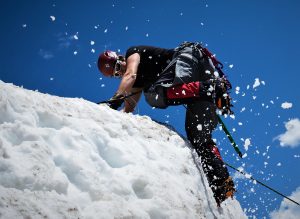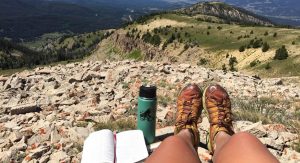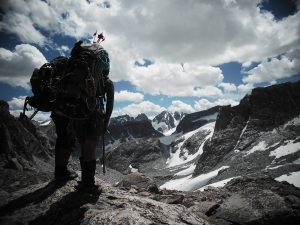“What boots should I buy for my course?”
There are few things in the backcountry that can inspire as much loathing as a bad pair of boots. Perpetually wet and blistered feet can take much of the enjoyment out of an otherwise great experience but the right boot will solve many of those problems. Solid Rock Outdoor Ministry or SROM courses can place high demands on footwear and difficult conditions can exacerbate any problems. Selecting the right footwear for your SROM course can be a challenge but we are here to help you find the right boots. This is a bit technical but hang with me for a little boot education.
The SROM 40/40 Course highlights better than any other SROM course the importance of not only having a good boot but having the correct boot. Throughout the 40/40 we experience wet and muddy trails, large temperature swings, difficult terrain, and snow. Good boots will keep your feet dry and comfortable hiking long days in these conditions but, unlike boots for our other courses, they also need to be stiff and stable for mountaineering. An ideal backpacking boot is lightweight, waterproof, breathable, supportive, and feels natural to walk in. An ideal mountaineering boot has a stiff sole to facilitate kicking steps and crampon use. This requirement generally makes full on mountaineering boots heavier and less comfortable, even feeling a bit like walking in ski boots. In selecting boots there is a tradeoff between the need for security and stability while mountaineering and comfort and efficiency while backpacking.
Most of the 40/40 is spent backpacking so one may be inclined to choose a backpacking boot to maximize comfort on the trail, however, while mountaineering the security afforded by a proper mountaineering boot inspires confidence and mitigates some risks associated mountaineering. An inappropriate boot may lead to increased risk of falls on snow or ice. During the mountaineering portion of the course it may also become painful to kick steps in the snow day after day with improper boots that fail to protect your feet. This discomfort can lead to improper technique which, again, results in increased risk. These increased risks make a basic backpacking boot a poor choice for the 40/40. For other SROM courses these backpacking boots would be ideal.

Others, wanting to feel as secure as possible on snow and ice, may wish to use an all-out mountaineering boot. This too is a mistake. While the boot will perform wonderfully while mountaineering a heavy duty mountaineering boot will likely cause other issues. The extra weight will make the long days feel longer, the extra stiff boot is more likely to cause blisters, heavier construction will take longer to dry if they get wet, they are somewhat “clunky” to walk in, and some are too warm for summer use. These factors also lead to risks: blisters can be extremely uncomfortable, even debilitating in severe case, and “clunky” boots may increase the risk of tripping or spraining an ankle.
Having owned many boots I’ve discovered that it can be tricky to find a boot that performs while mountaineering yet are also comfortable for extended backpacking. In some circles, especially in Europe, boots are categorized as B0, B1, B2, or B3 and I find this nomenclature extremely helpful.
- B3 boots are to be avoided unless your SROM CIP specifically requires B3 boots. As of this publication there are no SROM courses for which B3 boots are suitable. A B3 boot is designed for heavy duty mountaineering and can be identified by an extremely stiff sole (you will likely be unable to bend it at all) as well as crampon attachments at the front and rear of the boot.
- Most B2 boots are a great choice for the 40/40 but are probably overkill for any other SROM course. Be sure they are comfortable to walk in. These boots are still great for mountaineering but are much more comfortable to walk in. The easiest way to identify a B2 boot is presence of a rear crampon attachment and the lack of a front crampon attachment. The sole will also be quite stiff but you may be able to bend it a little.
- B1 boots can also be a good choice for the 40/40 and most other SROM courses. For the 40/40 you will want a model closer to the top of the range with a very stiff sole and great support. These boots are often designed with heavy backpacking as the primary design consideration and will have no crampon attachments. It may be helpful to compare B1 boots to B2 boots sold at the same store; if the stiffness of the sole is similar it will likely be a great choice for the 40/40. Another way to test is the boot should be stiff enough to stand on the first half inch of the toe and still provide support for the whole foot. If the toe bends up too far or you feel strain in your foot it is probably a B0 boot.
- B0 boots are essentially any boot that does not meet the criteria for the above boots and they are great on many SROM backpacking courses, though a B1 boot may be better for very heavy loads. However, they are not allowed on the 40/40 due to the additional risk they present during mountaineering. They can also be very hard to distinguish from a B1 boot. They are also, by far, the most popular boots sold in the United States and it is highly likely this is what you own if you already have a pair of hiking boots. A B0 boot may look virtually identical to a B1 boot but lacks the stiff and stable platform needed for mountaineering. Virtually all boots retailing under $200 are B0 boots as well as many that cost much more.
So… what boot should I buy? In general terms for the 40/40 buy a solid B1 or B2 boot; for other SROM courses a B0 or B1 boot is going to be more suitable, just be sure it is sufficient to support the loads you will be carrying. Consult your Course Information Packet. Try on the boots before buying them if at all possible and plan time to break them in before the course, some of the heavy leather boots may have long break in periods, sometimes upwards of 100 miles with a heavy pack. Regardless of the type of boot fit is critical. Ask a salesman for help properly fitting your boots. If using the boots for mountaineering find a hard surface, like concrete or other solid object, to firmly kick and be sure the boot protects your toes. If your toes hit the end of your boot or otherwise feel pain try another boot.
Don’t assume a boot will be great for you because someone else loves it as some foot shapes work better with certain brands and models. If you plan to continue to use your boots after a long course like the 40/40 durability is a consideration. Boots designed for lightweight and high performance can frequently sacrifice durability in pursuit of greater performance. The lighter LaSportiva Trango models, B2 boots, are the only boots that have never given me blisters no matter what the conditions. It is perfect for many of the things I love to do. The durability, however, is disappointing if you spend significant time hiking in them. With my use, I am lucky to get 2 years out of a pair but they perform so well I keep buying them. This is something to consider as boots are expensive.
The health of your feet is very important as they are your mode of transportation. Therefore, your boots are one of your most important pieces of equipment. Your comfort, safety, and success will be influenced by your choice of footwear. SROM has a list of boots that have worked well for past students and instructors but the most important thing is to find a boot in the correct category that fits properly. Good luck, please contact us with any questions regarding selecting boots for your course.


